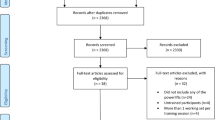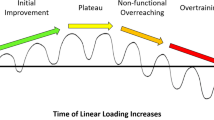Abstract
Experience derived from performance sports documents that based on strength assessment resistance exercise training can be planed, performed and prescribed effectively. For novice athletes starting a health-oriented resistance exercise training however, it is not the problem of accuracy of the measurement procedure which forms the main focus, but how to prescribe the exercise intensity based on various possible variants of strength testing. Maximal strength is usually defined as the heaviest load that can be lifted for one repetition maximum and is measured by one-repetition maximum tests or by repetition-to-fatigue testing as a prediction model. The current paper critically considers these forms of maximum testing related to novice resistance exercise trainers especially during the phase of adaptation to a progressive training regiment, and discusses the possibility of prescribing training intensity by using the number of repetitions as alternative during this phase.
Zusammenfassung
Erfahrungen aus dem Leistungssport zeigen, dass basierend auf diagnostisch ermittelten Kraftwerten ein adaptationswirksames Krafttraining geplant, durchgeführt und gesteuert werden kann. Im gesundheitsorientierten Krafttraining besteht aber bei Trainingseinsteigern weniger ein Problem der Messgenauigkeit, als vielmehr das Problem der Intensitätssteuerung über kraftdiagnostische Verfahren. Die in der Sportpraxis verwendeten Verfahren Ein-Wiederholungsmaximum, sowie regressionsanalytische Verfahren zur Bestimmung der Maximalkraft werden im vorliegenden Beitrag kritisch beleuchtet und eine Belastungssteuerung in der ersten Phase eines langfristigen Trainingsprozesses über Vorgabe von Wiederholungszahlen diskutiert.
Similar content being viewed by others
Literatur
American College of Sports Medicine. The recommended quantity and quality of exercise for developing and maintaining cardiorespiratory and muscular fitness in healthy adults, Med Sci Sports Exerc 22, 265-274, 1990
Radlinger L, Bachmann W, Homburg J, Leuenberger U, Thaddey G. Rehabilitatives Krafttraining, Stuttgart New York, Georg Thieme Verlag, 31-47, 1998
Hollmann W and Hettinger T. (2000). Sportmedizin – Arbeits- und Trainingsgrundlagen. Schattauer, Stuttgart
Schlumberger A and Schmidtbleicher D. (2000). Grundlagen der Kraftdiagnostik in Prävention und Rehabilitation. Manuelle Medizin 38: 223–231
Zimmer M. Entwicklung und Erprobung eines Mehrwiederholungstests zur Erfassung der Kraftleistung im Fitnesstraining. Saarbrücken, Diplomarbeit am Sportwissenschaftlichen Institut der Universität des Saarlandes, 1999
Güllich A and Schmidtbleicher D. (1999). Struktur der Kraftfähigkeiten und ihre Trainingsmethoden. Deutsche Zeitschrift für Sportmedizin, 50(7+8): 223–234
Schnabel G, Harre D, Krug J. Trainingslehre – Trainingswissenschaft Leistung Training Wettkampf, Aachen, Meyer & Meyer Verlag, 166-168, 2008
Boeckh-Behrens WU and Buskies W. (2000). Fitness-Krafttraining. Reinbeck bei Hamburg, Rowohlt Verlag
Ploutz-Snyder LL and Giamis EL (2001). Orientation and familiarization to 1 RM strength testing in old and young women. J Strength Cond Res, 15(4): 519–523
Buskies W. (1999). Sanftes Krafttraining – unter besonderer Berücksichtigung des subjektiven Belastungsempfindes. Köln, Sport und Buch Strauß
Gordon NF, Kohl HW, Pollock ML, Vaandrager H, Gibbons LS and Blair SN. (1995). Cardiovascular safety of maximal strength testing in healthy adults. American J Cardiology, 76: 851–853
McCartney N. The safety of resistance training: hemodynamic factors and cardiovascular incidents. In: JE Grave & BA Franklin (eds.) Resistance Training for Health and Rehabilitation Champaign IL, Human Kinetics 83-93, 2001
Bellew JW. (2002). Older adults and one-repetition maximum testing: what about injuries. Strength and Cond J, 24(1): 60–62
Cronin JB and Henderson ME. (2004). Maximal strength and power assessment in novice weight trainers. J Strength Cond Res 18(1): 48–52
Mayhew JL, Johnson BD, LaMonte MJ, Lauber D and Kemmler W. (2008). Accuracy of prediction equations for determining one repetition maximum bench press in women before and after resistance training. J Strength Cond Res 22(5): 1570–1577
Heller M. Zur Problematik der Trainingssteuerung über die Belastungsintensität bei fixierten Wiederholungszahlen im Krafttraining – Interindividuelle und intraindividuelle Unterschiede bei den Übungen Bankdrücken und Bankziehen. Diplomarbeit am Zentrum für Sportwissenschaft und Universitätssport der Universität Wien, 2010
Desgorces FD, Berthelot G, Dietrich G and Testa MS. (2010). Local muscle endurance and prediction of 1 repetition maximum for bench in 4 athletic populations. Strength Cond Res 24(2): 394–400
MacDougall JD, Tuxen D, Sale DG, Moroz JR and Sutton JR (1985). Arterial blood pressure response to heavy resistance exercise. J Appl Physiol 58(3): 785–790
MacDougall JD, McKelvie RS, Moroz JR, Sale DG, McCartney N and Buick F (1992). Factors affecting blood pressure during heavy weightlifting and static contractions. J Appl Physiol 73: 1590–1597
Fleck SJ. Kardiovaskuläre Reaktionen während Kraftbelastungen. In: PV Komi (Hrsg.) Kraft und Schnellkraft im Sport. Köln, 302-311, 1994
Author information
Authors and Affiliations
Corresponding author
Additional information
Eingegangen am 14. März 2010, angenommen am 15. März 2010
Use of strength assessment to determine and manage intensity of strength training in healthy people
Rights and permissions
About this article
Cite this article
Tschan, H. Einsatz der Kraftdiagnostik zur Bestimmung und Steuerung der Belastungsintensität im gesundheitsorientierten Krafttraining. Sportmed Präventivmed 40, 16–18 (2010). https://doi.org/10.1007/s12534-010-0083-1
Published:
Issue Date:
DOI: https://doi.org/10.1007/s12534-010-0083-1




